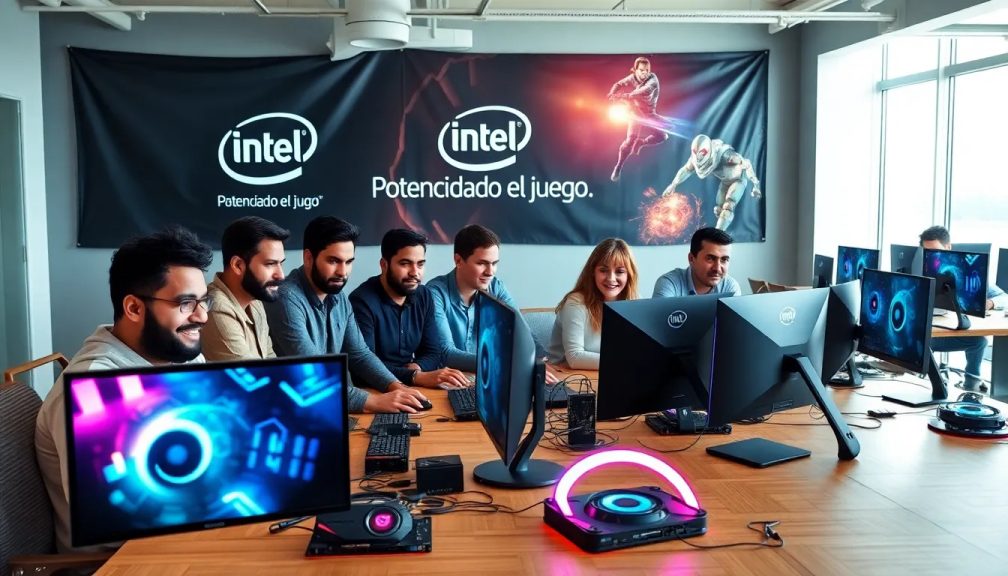Intel hires engineers to enhance PC gaming with dedicated Arc graphics

The fast-paced world of hardware development often reveals insights about future product launches through the companies themselves. Recently, discussions arose regarding the potential discontinuation of Intel's Arc GPUs until the Druid architecture is introduced, following a partnership with NVIDIA. However, a recent job posting from Intel indicates that the company is still actively pursuing advancements in this area. They are on the lookout for a performance engineer focused on optimizing and validating gaming performance with dedicated graphics cards. Is this a sign that the Celestial and Druid architectures require additional support?
This move by Intel is strategic. The company recognizes the need to strengthen its position in a market where AMD has been firmly established for years, particularly in terms of processors that complement top-tier graphics cards. To compete effectively, it is not sufficient to simply have a higher IPC (instructions per cycle) or more cores; it is crucial to consider how CPUs and GPUs communicate, manage PCIe latency, maintain stable frame rates, and ensure energy efficiency during extended gaming sessions. This new role will play a pivotal part in these efforts, especially as Intel addresses vacancies resulting from layoffs and early retirements.
Intel is looking for an engineer to optimize and validate gaming performance
Intel's recent job posting underscores the necessity of bolstering their GPU dedicated sector. The details of the position reveal a clear intention to enhance their gaming performance capabilities:
The Intel Silicon Architecture, Power and Performance (SiA PTP) team is seeking a highly qualified System on Chip (SoC) performance engineer to join us, specifically focused on validating and optimizing video games for desktop products. In this role, you will have the opportunity to work with cutting-edge technology and be responsible for optimizing and validating gaming performance in our high-end desktop SoC designs, with a strong emphasis on dedicated graphics performance (dGFX).
What stands out in this job listing is Intel's emphasis on dGFX gaming performance. This indicates that the focus will not be on integrated graphics (iGPU) within their processors, but rather on how their desktop CPUs perform when paired with high-end dedicated GPUs, specifically the Arc series. This scenario accurately reflects the typical setup in a serious gaming PC.
A role that encompasses both GPUs and CPU aspects for gaming
In this position, engineers will conduct tests on both AAA titles and esports games, utilizing modern APIs like DirectX 12 Ultimate and Vulkan, as well as game engines such as Unreal Engine 5. Key metrics to be assessed include:
- Minimum FPS and percentile performance
- Frame pacing consistency
- Scalability with multiple cores
- Power consumption and thermal efficiency
Today’s gaming processors must avoid overheating and excessive power draw, as these issues can negatively impact the user experience, even when paired with the best GPUs available.
Moreover, engineers in this role will not merely run benchmarks like 3DMark and record scores. The real work involves identifying bottlenecks, proposing firmware modifications, validating communication between CPUs and GPUs with technologies like ReBAR or DirectStorage, and ensuring that users achieve optimal performance when integrating Intel processors with NVIDIA, AMD, and especially Arc graphics cards. This indicates that Intel is committed to enhancing the overall gaming experience.
This job offer is more than just another vacancy on Intel's website; it signals the company's intent to intensify its focus on the desktop gaming market at a time when many believed they were stepping back. The pursuit of such specialized profiles indicates that something significant is brewing in their labs. There’s also a possibility that they are grappling with how to direct the Celestial architecture following internal challenges, but it appears improvements are gradually being made. Regardless, the clear takeaway is that the Arc series will continue to be a part of their strategy for the foreseeable future.
Context and implications for the gaming industry
Intel's renewed commitment to the gaming segment comes at a crucial time. The gaming industry is characterized by rapid technological advancements and shifting consumer expectations. As gamers demand higher performance and better graphics, companies like Intel must adapt quickly.
By focusing on optimizing both CPU and GPU interactions, Intel aims to provide a seamless gaming experience. This includes ensuring that their processors can handle demanding games while efficiently communicating with high-performance graphics cards. This dual focus is essential as:
- Gamers increasingly seek systems that deliver higher frame rates.
- The rise of high-resolution and VR gaming intensifies the need for powerful hardware.
- Competitive gaming requires low latency and rapid response times.
In this environment, Intel’s efforts are not merely about launching new products but also about enhancing existing technologies to meet market demands. The strategic hiring of performance engineers is a proactive step toward cementing their place in the competitive gaming landscape.
The future of Intel's graphics cards: What’s next?
As Intel continues to develop its Arc graphics cards, the focus on dedicated gaming performance will shape the future of their product line. Analysts and enthusiasts alike are keen to see how these developments unfold, especially in light of the competition from NVIDIA and AMD. The introduction of advanced features and improved architectures will be crucial in determining the success of Intel's gaming efforts.
For instance, upcoming features may include:
- Enhanced ray tracing capabilities
- Improved AI-driven performance optimizations
- Support for next-generation display technologies
The ongoing collaboration with software developers will also play a vital role in ensuring that Intel graphics cards can effectively harness the power of contemporary gaming engines and APIs.
To gain more insights into Intel's efforts in the gaming graphics space, check out this video that explores the performance of Intel Arc graphics cards:
In conclusion, the job posting for a performance engineer is a clear indication that Intel is not only committed to staying relevant in the gaming sector but is also prepared to invest in the talent necessary to innovate and improve its offerings. As the landscape continues to evolve, Intel's strategic moves will be closely monitored by industry experts and gamers alike, eager to see how the company rises to the challenge and enhances the gaming experience.




Leave a Reply